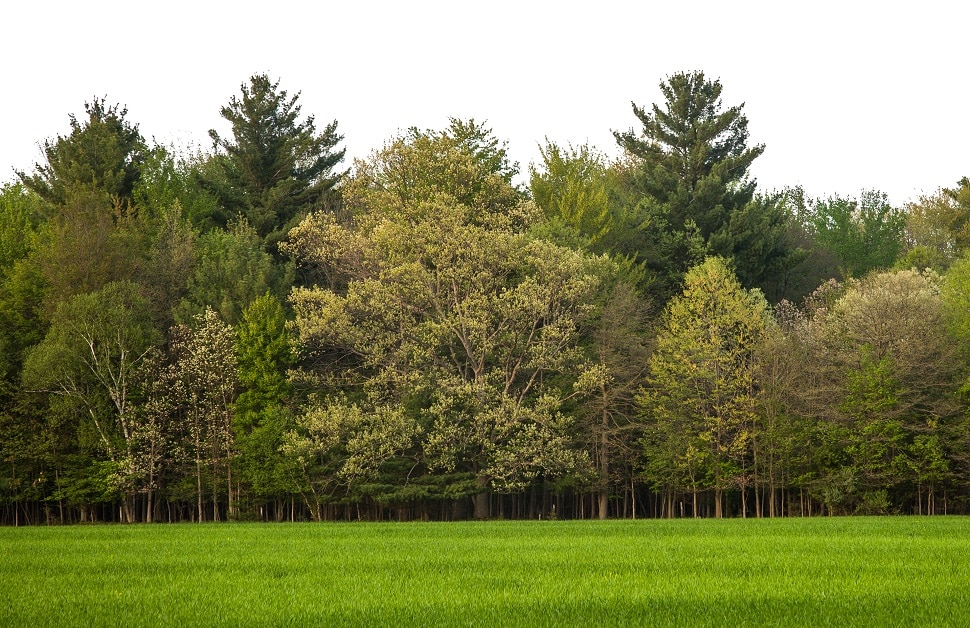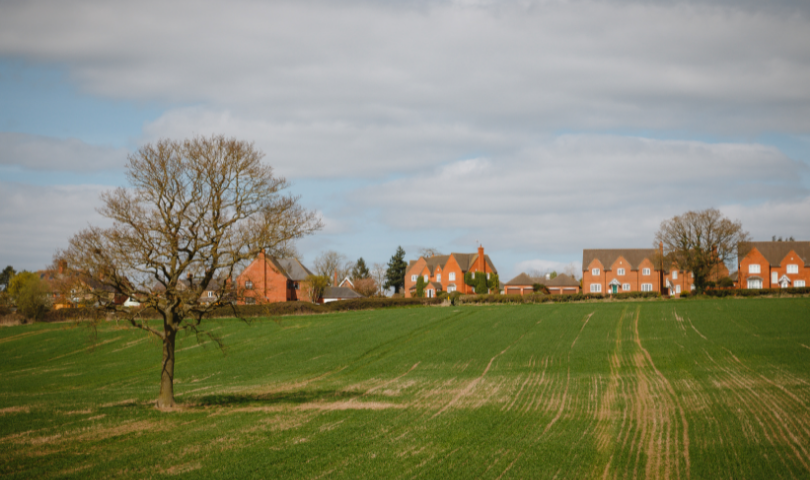
This is a guide to planning policy in the Green Belt.
In this guide you will learn:
- What defines the Green Belt
- The planning restrictions on Green Belt land, according to the National Planning Policy Framework
- Current criticism of the Green Belt
- What are `Very Special Circumstances’ when it comes to getting planning permission?
- How to make a `special case’ for a planning application in the Green Belt
- Key points, examples of successful applications and expert views
So, if securing planning consent in the Green Belt is important to you, let’s get started.
What is the Green Belt?
The Green Belt is a designated zone of protected land around major cities and towns aimed at preventing urban sprawl from towns merging into one another. A common misconception is that the UK Green Belt comprises beautiful swathes of green countryside with ecological significance or agricultural value, whereas in fact, it includes many areas of scrubland and semi-derelict land on the outskirts of urban areas. A key principle of central Government’s stance on Green Belt land is clarified in Chapter 13 of the National Planning Policy Framework (NPPF) which states: `The fundamental aim of Green Belt policy is to prevent urban sprawl by keeping land permanently open; the essential characteristics of Green Belt are their openness and their permanence.’
The amount of Green Belt land in England was estimated at 16,140km2 at the end of March 2021, shrinking by around 1% since 2006. In 2020/21, Green Belt land was reduced by around 18km2 due to local authorities adjusting the size of their Green Belt (House of Commons Library, 2021). In current planning terms, as much brownfield land or previously developed land should be considered for development first, then greenfield sites which comprise previously undeveloped land such as grassland; while greenfield sites do have protections against development, they are not as stringent as those applied to Green Belt land.
The National Planning Policy Framework
According to Paragraph 147, `Inappropriate development is harmful to the Green Belt and should not be approved except in very special circumstances.’ The NPPF states that when considering any planning application, the strategic policy making authority should give `substantial weight to any harm to the Green Belt,’ and `very special circumstances’ will not exist unless the potential harm to the Green Belt by reason of inappropriateness, and any other harm resulting from the proposal, is clearly outweighed by other considerations. Local authorities should also regard the construction of new buildings in the Green Belt as inappropriate.
The circumstances when building a property in an isolated rural area may be relevant are outlined in Paragraph 80 (updated from Paragraph 79 in July 2021): these include housing for agricultural or forestry workers; development that would enhance a heritage asset; reuse of a disused building to enhance the area; where an existing building would be subdivided or where a building would achieve outstanding design criteria, raising the standard of design in the local area and being sensitive to it.
Clearly, developing Green Belt land is challenging and identifying Green Belt planning loopholes is extremely difficult; the only exceptions which local authorities may consider regarding development in the Green Belt are:
- Buildings used for agricultural or forestry purposes.
- Facilities associated with outdoor sports or recreation, cemeteries or allotments providing that the openness of the Green Belt is preserved.
- Extensions or alterations to existing buildings which remain proportionate with the character of the original.
- Replacement of a building according to the above parameters.
- Limited affordable housing for local community needs.
- Limited infill in villages which would not harm the openness of the Green Belt.
- Other development termed `not inappropriate’ includes mineral extraction, engineering operations and local transport infrastructure.

Criticism of the Green Belt
- The release of strategic Green Belt land for residential development could clearly alleviate the UK’s severe housing crisis.
- The Green Belt designation forces growth into densely populated urban areas leading to developers building ever-smaller flats, or into rural areas outside the Green Belt, making commuters travel further to jobs which is detrimental to both the environment and their quality of life.
- Protecting Green Belt land has been blamed for pushing up the price of available property by restricting the amount of land available for residential development, and for adding to inequality by creating a barrier to those who cannot afford to live in city centres.
- Limiting sustainable economic development.
- Some housing development is forced to take place on flood plains due to Green Belt constraints.
- Whilst widely believed that development of the Green Belt will damage the natural environment, as stated above, Green Belt includes large areas of derelict land. Areas of green space which need protection could be given specific designations such as Area of Outstanding Natural Beauty, national parks, protected woodland, Sites of Special Scientific Interest or conservation areas.
What are Very Special Circumstances (VSC)?
These are a range of factors which could potentially unlock a route to securing planning consent in the Green Belt. However, a single reason, such as housing need, will not be sufficient; a successful VSC case will comprise a collection of material considerations in support of a scheme.
Due to the government’s stance on protecting Green Belts and preventing urban sprawl, the development industry has shown little enthusiasm for attempting to obtain consents there, despite significant shortfalls in local planning authorities’ housing supply, but VSC do exist. They are not relevant unless the potential harm to the Green Belt, due to inappropriateness and any other harm, is outweighed by other considerations: the level of harm is as important as the benefit.
It is essential that the immediate impact of a proposed development would be limited and that the benefits or compensatory measures – more than just housing provision – would put it ahead of other alternative sites by significantly enhancing the area. Relevant sections of the NPPF include Paragraph 144 which states that where potential harm is `clearly outweighed’ by other considerations’, this can justify inappropriate Green Belt development and represents VSC.
An application must prove that its benefits outweigh the resulting harm to Green Belt, bearing in mind Paragraph 145 which states: “Inappropriate development is, by definition, harmful to the Green Belt and should not be approved except in very special circumstances.”
In certain instances, infill sites may qualify; these are usually within or immediately adjacent to neighbouring towns or built-up areas, and providing that there is sufficient existing infrastructure and transport connections, infill is considered to be less impactful than isolated sites which are less sustainable.
Paragraph 11 of the NPPF states that there is a presumption in favour of proposed development for buildings or infrastructure which promotes high levels of sustainability. Planning consent on Green Belt land relies on the outstanding design criteria and to achieve success, an application must be mindful of this.

How to make a special case for a planning application in the Green Belt
Proving VSC is challenging and requires a strongly evidenced case. Christopher Young QC, of No.5 Barristers Chambers in Birmingham, commented that there are seven key factors relevant to securing planning consent on Green Belt land:
- The most important benefit is if the site is included in a draft allocation for an emerging local plan.
- The site includes partial previously developed land.
- If the council accepts the need for Green Belt release on greenfield land.
- The existence of un-met housing need (this is not sufficient reason alone).
- If the site is visually contained.
- If a scheme could enhance or support educational facilities.
- Close proximity to a railway station, a need for elderly housing, exceptional architecture or creation of public open spaces.
A successful VSC application
An application for the development of a business park in Ripley, Derbyshire is an example of a case where special circumstances won the day for the applicant at Appeal. In September 2020, Amber Valley Borough Council considered a proposal for an extension to Denby Hall Business Park, involving the construction of new B1, B2 and B8 use units.
Garner Aluminium Extrusions (Garnerlex) wanted to relocate to a site at the Business Park to share common facilities and operations with LB Plastics, a firm which would supply the majority of its products to Garner Aluminium Extrusions. LB Plastics was acquired by Garner Aluminium Extrusions in an expansion move and both firms needed bigger premises.
Expanding at Denby Hall would mean that 780 jobs would be maintained or created, and there was a business need for both firms to be located on the same site to share common facilities, logistics and transport. In consideration of the VSC, the appeal report found “a justifiable case for efficiency, stability and growth of two interconnected businesses.”
The economic case was found to have been made and there were significant VSC considerations. In conclusion, the report considered that while there was harm to the natural environment, following an overall assessment of the benefits and drawbacks of the scheme, on balance the proposal resulted in a sustainable form of development as defined by Paragraph 8 of the NPPF.
It was considered that the approval would not only secure existing jobs in the short term, it would also create job growth in the short and longer term and while there was “no doubt harm to Green Belt as a result of the application, the significant benefits are considered to outweigh that harm, therefore the proposal is considered to meet the requirement of `Very Special Circumstances’ and the principle of development was found to be acceptable.”
Considering the application of policies within the NPPF that protect areas and assets of importance, the proposal was not considered to provide a clear reason for refusal as the VSC’s of allowing development in Green Belt were met, therefore in accordance with Paragraph 11 d of the NPPF, the proposal was recommended for approval.
James Corbet Burcher, junior barrister at No.5 Barristers Chambers in Birmingham, said that there are two key principles when appealing for Green Belt consent:
1. Get the structure of the VSC clear; these must outweigh all the harm done by the application.
2. There is a need, and no alternative sites or allocation in the Local Plan for such development.
Despite these two key elements being in place with the Denby Hall example, the local planning authority opposed the application all the way to Appeal, with councillors unwilling to grant it despite the jobs it would create. The Local Plan had not been updated since 2016 and it was not obvious when it might be put in place.
There were obviously clients wanting the site, a clear operational need for them to be located adjacent to the business park and a lack of alternative sites within the borough. Mr. Corbet Burcher said that his team broke their submission down into categories: jobs, economic growth, innovation through clustering and environmental benefit through transport issues and reduction of emissions.
He said there is some ambiguity in the government’s advice, and it is vital to create a clear structure for a VSC case at the start, then add detail. The team focused on local issues, noting that a fifth of local jobs were in manufacturing; they also examined local unemployment rates, benefit claimant rates and the contribution that the scheme could make to sustaining the area’s manufacturing industry.
Examination was also made of nearby villages to demonstrate ways in which they would benefit. It also helped that this was not a speculative application as there was an employer already on site. Mr. Corbet Burcher commented that it is important that the client talks to the Appeal Inspector about their operation, making sure that they understand, for instance in this case, why buildings needed to be of a certain size to carry out an element of the manufacturing process.
He added that it was important to make it clear that the Local Plan process had stalled, and that people need jobs, explaining why the Local Plan is out of date and why an emerging plan will not provide the answer, or not quickly enough.
Key points for success with a VSC case
A rigorous assessment of the scheme is required, points must be clarified to help the Inspector and it is vital to outweigh all the harm done by a development; simply the absence of harm is not enough. Also, exceptional circumstances are not limited to need; consider employment for instance – there may be jobs combined with other factors to make a VSC case and the absence of alternative sites is essential.
Environmental benefit must be related back to the Green Belt by considering the configuration of a site, and it is important to demonstrate benefit to the local community by providing economic data to support the employment angle.
The benefits of a scheme over and above housing development must be demonstrated; it is important to understand levels of need in the district and enhance the affordable housing offer, being aware of the length of waiting lists and the prospects of a local authority acting to improve the situation. If there is no affordable housing allocation for some years, it is advisable to ascertain whether there are sufficient affordable housing sites in the pipeline and clarify the numbers and severity of the problem.
Consideration may be given to other specialist housing needs such as self-build, or sport and recreation provision and public access: assess what a community needs by studying the Neighbourhood Plan and local magazines. Landscaping plans are also important; if a scheme is enclosed it may lend itself to innovative landscaping possibilities.
To enforce these points, it is important to explain why the local council fails and that the emerging Local Plan does not provide solutions; the Local Plan process may also be on hold or not progressing at all. It is important to emphasise the contribution of development on local employment, especially in areas facing economic problems. The government’s `levelling up’ strategy may provide traction here as the initiative gains clarity, leading to possibilities in terms of creating employment in deprived areas.
Regarding `other harm’ landscape considerations, it may be possible to use Biodiversity Net Gain to advantage by highlighting a site’s unique characteristics, explaining how the natural environment could benefit while persuading the Inspector that due to the exceptional quality of the scheme, it will not get tied down in reserve matters after planning permission is granted.

Playing the long game
Planning consultant Eleni Randle of the Eldnar Consultancy, commented that while difficult, it is not impossible to get planning permission on Green Belt land providing that use is made of the rules as they stand. “It is often a long game, requiring leverage of the regulations,” she said. “For instance, a steel portal agricultural building may benefit from prior approval under Class Q and once the principle of a residential unit is secured, it may be possible to swap this for a new-build house.
“The use of fall-back positions is becoming a popular route to navigate opportunities within the Green Belt as the principle of housing has already been established; the new proposal should generally be equal to, or ideally less, than the original proposal in terms of volume and/or footprint to create a betterment to the openness of the Green Belt.”
Eleni secured consent on a Green Belt site involving a very dilapidated bungalow on a large plot in the Wyre Forest District. She explained: “We first secured certificates of lawfulness to confirm what would be possible in terms of extensions to the rear of the bungalow, and then secured a Class AA approval for an upward extension of an additional storey, under the prior approval mechanism.
Once approved, we approached the Local Planning Authority outlining that whilst we could carry out these extensions, they were likely to be bulky and unattractive. We were able to utilise the potential volumes to secure a new build dwelling which was overall smaller in volume than the fall-back positions established. This was approved and now a beautiful, modern house is under construction.”
Regarding appeals relating to planning permission in the Green Belt, Eleni emphasised the importance of evidencing everything that an appellant wants an Inspector to take into account to support their argument against the refusal reasons. “Put all relevant information in the appeal file; an Inspector is not there to find evidence for you, they are there to determine the appeal based upon the evidence before them only.
“While referring to other sites is acceptable with regard to general approach, each case must be considered on its own merits. Keep your submissions concise and address the reasons for refusal as your main focus within your statement.
“Unless there is a specific need (for example within councils where the Local Plan is not up-to-date and the proposal is falling in the context of the “tilted balance”) there is generally limited point in repeating at length what is acceptable, or highlighting a lack of objection, as these are generally neutral considerations. Overall, bear in mind that several applications may be required to achieve the desired result.”
Call for industry discussions
Nial Casselden, associate director at Fisher German, said that the development industry wants to be part of discussions about how Green Belt can play a role in solving the current housing issue. He said: “Amid a housing crisis, the issue of Green Belt has been at the forefront of the debate over where the country’s desperately needed new houses are going to be built. Green Belt is long-standing policy, and often a highly emotive subject.
“Green Belt is also much misunderstood. It seeks to prevent urban sprawl by keeping land permanently open. Green Belt areas are not just countryside, and it is not designed to protect beautiful landscapes. Land within the Green Belt can be very poor in quality.
“Many councils have their towns tightly constrained by Green Belt. This means that it often proves extremely challenging to find the land for new housing. Whilst there is often much talk of using ‘brownfield’ land, it often comes with significant obstacles. It tends to be true that houses built on ‘brownfield’ land are less viable, meaning that something must give – either commuted sum payments normally made by developers to help pay for roads, schools and hospitals, or the provision of low-cost affordable housing. Town centre development also tends to be higher-density and dominated by flats, which are often not suitable for families.”
Nial added: “In addition to the housing crisis, we are also in a climate crisis, and there is a significant role to play for ‘brownfield’ development as it recycles land and can be highly sustainable. However, we know from experience that ‘brownfield’ land alone cannot meet our housing needs, and there needs to be a balance between ‘brownfield’ and ‘greenfield’ development, in a sustainable way.
“Unfortunately, the debate over Green Belt is very political. The question of whether Green Belt sites should be developed has derailed many local plans, with the consequence that housing need has intensified. The debate is surely to rage over the coming years, as the Government looks to overhaul the planning system to make it fit for purpose in responding to the housing and climate crises. Most in the development industry want to engage in a sensible debate over the future of the Green Belt and how it can be part of the solution to meet our future needs.
“Although it is challenging, that does not mean that it is impossible to develop in the Green Belt. In fact, planning policy contains a range of development types that can be acceptable. These range from extending or replacing buildings, sport and recreation facilities, changes of use of land and buildings and the provision of affordable housing to meet local needs. There are usually options available, and early engagement with a planning consultant with experience of dealing with Green Belt applications is always strongly advised.”
Green Belt review needed
Director of Planning at development experts Rural Solutions, Duncan Hartley said: “As a designation, speaking from the private sector, it is understandably incredibly difficult to meet the tests for consent in the Green Belt, especially where some local authorities are blindly applying policy without site context. Green Belt exists for one purpose, to protect openness. It is absolutely necessary to have the Green Belt, however, the issue is about its use and application, which has been extended beyond the scope of what it should be doing. Green Belt has become almost a sacred cow for central and local government.”
Mr. Hartley said he sees no evidence of imminent changes to Green Belt boundaries, adding that since the Conservative Party’s shock defeat in the Chesham and Amersham by-election in June, blamed in part on its announcements to reform the planning system, little of substance has emerged from government about these much-vaunted new plans.
“I feel we have lost track of the meaning of Green Belt and its use,” added Mr. Hartley. “It needs a fundamental review in terms of meeting residential and employment needs across the nation, and it should be part of the levelling-up debate – it may be just a part of the answers in this, but a significant part.”
Conclusions
Some councils are finding themselves in situations where promoting Green Belt land is the only way for them to meet their level of housing need. The Green Belt is under pressure, and this has been noted by the Strategic Land market. Developers are seeking strategic land in and around the Green Belt and taking a long-term view: the low cost of Green Belt land due to the restrictions on it, offers the prospect of substantial gains. However, the process of promoting such land takes time and is costly; a 5–10-year view is being taken by land promoters, but such applications are increasing as councils review their land policies. While appeals are unpredictable and the results subjective, the planning system looks set fair for turbulent times as it contemplates the future of Green Belt.
References
UK Parliament. 2021. House of Commons Library. Green Belt. [Online]. Available from: https://commonslibrary.parliament.uk/research-briefings/sn00934/ (Accessed 25th November 2021)
GOV.UK. 2021.Green Belt. [Online]. Available from: https://www.gov.uk/guidance/green-belt (Accessed 25th November 2021)
GOV.UK. 2021. Planning permission. [Online]. Available from: https://www.gov.uk/browse/housing-local-services/planning-permission (Accessed 25th November 2021)
GOV.UK. 2021. National Planning Policy Framework. [Online]. Available from: https://www.gov.uk/government/publications/national-planning-policy-framework–2 (Accessed 23rd November 2021)
No5 Barristers Chambers. 2021. [Online]. Available from: https://www.no5.com/ (Accessed 23rd November 2021)




